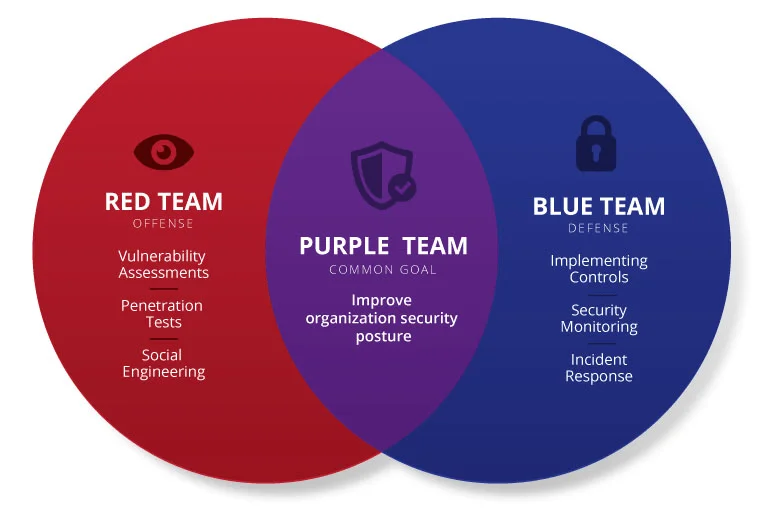 In today’s rapidly evolving cybersecurity landscape, organizations must adopt proactive strategies to stay ahead of adversaries. One such strategy is Purple Teaming, a collaborative approach that bridges the gap between offensive (Red Team) and defensive (Blue Team) security practices. This blog post dives into the core concepts of Purple Teaming, its foundational principles, and how it can transform your security program into a threat-informed defense powerhouse.
In today’s rapidly evolving cybersecurity landscape, organizations must adopt proactive strategies to stay ahead of adversaries. One such strategy is Purple Teaming, a collaborative approach that bridges the gap between offensive (Red Team) and defensive (Blue Team) security practices. This blog post dives into the core concepts of Purple Teaming, its foundational principles, and how it can transform your security program into a threat-informed defense powerhouse.

What is Purple Teaming?
Purple Teaming is not just another team to build—it’s a capability to generate. It’s about optimizing the relationship between adversary emulation and defense teams to create a continuous feedback loop that strengthens your security posture. By combining the expertise of Red and Blue Teams, Purple Teaming ensures that your defenses are aligned with real-world threats and business outcomes.
Key Concepts of Purple Teaming
1. Threat-Informed Defense
At its core, Purple Teaming is a practical expression of Threat-Informed Defense. This approach leverages three key elements:
– Cyber Threat Intelligence Analysis: Understanding the tactics, techniques, and procedures (TTPs) of adversaries.
– Defensive Engagement: Actively testing and refining defenses against these threats.
– Focused Sharing and Collaboration: Ensuring that insights and improvements are shared across teams and organizations.
2. MITRE ATT&CK Framework
The MITRE ATT&CK framework is a critical tool for Purple Teaming. It maps out adversary behaviors into logical steps (tactics) and techniques, providing a structured way to align security controls with real-world threats.
3. Emulation
– Emulation: Replicating the actual processes used by adversaries to achieve their goals.
4. The Role of the Manager-Planner
The Manager-Planner plays a pivotal role in driving Purple Teaming initiatives. They ensure that exercises are aligned with business outcomes, foster collaboration between teams, and demonstrate the value of threat-informed defense to stakeholders.
Why Purple Teaming Matters
Purple Teaming is not just about testing defenses—it’s about maximizing security ROI and enhancing enterprise defensibility. Here’s how:
– Aligns Controls to Relevant Threats: By focusing on real-world threats, Purple Teaming ensures that your security investments are effective and measurable.
– Improves Collaboration: It breaks down silos between Red and Blue Teams, fostering a culture of continuous improvement.
– Drives Business Outcomes: Security is not just about technology—it’s about protecting the mission and enabling business success.
How Purple Teaming Works
The Purple Teaming process is iterative and structured around four key phases:
Phase I: Orientation
– Understand Your Mission: What does your organization do, and how does it create value?
– Analyze Your Terrain: Map out your IT architecture and identify critical assets.
– Select Threats: Identify likely adversaries and their TTPs using tools like MITRE ATT&CK.
Phase II: Planning & Preparation
– Scope the Exercise: Define goals, establish control measures, and determine which controls to evaluate.
– Create an Emulation Plan: Align adversary techniques with specific controls to test.
– Empower Trusted Agents: Ensure senior stakeholders are informed and ready to guide the exercise.
Phase III: Execution
– Run the Emulation Plan: Execute the planned attacks and monitor the Blue Team’s response.
– Manage the Flow: Adjust the exercise in real-time based on the Blue Team’s performance.
– Debrief Daily: Conduct candid discussions to identify successes and areas for improvement.
Phase IV: Reporting & Remediation
– Deliver Reports: Provide tailored reports to stakeholders, highlighting key findings and recommendations.
– Mitigate Gaps: Implement compensating controls and revalidate updated defenses.
– Plan for the Future: Identify persistent gaps and level up the next exercise.
Getting Started with Purple Teaming
To launch a Purple Teaming program, you’ll need:
1. Stakeholder Support: Clearly articulate the benefits of Purple Teaming to leadership.
2. A Plan: Document your goals, emulation plan, and exercise schedule.
3. A Blue Team: Dedicated defenders to participate in the exercise.
4. Red Capability: Whether internal or external, you need a team or toolset to emulate adversary behaviors.
The Bottom Line
Purple Teaming is a game-changer for organizations looking to build a robust, threat-informed defense. By aligning security efforts with business outcomes, fostering collaboration, and continuously testing and refining defenses, Purple Teaming ensures that your organization is prepared to face even the most sophisticated adversaries.
Let’s turn your security program into a proactive, threat-informed defense machine. Together, we can make the adversary’s job harder—and your organization safer.

Leave a Reply